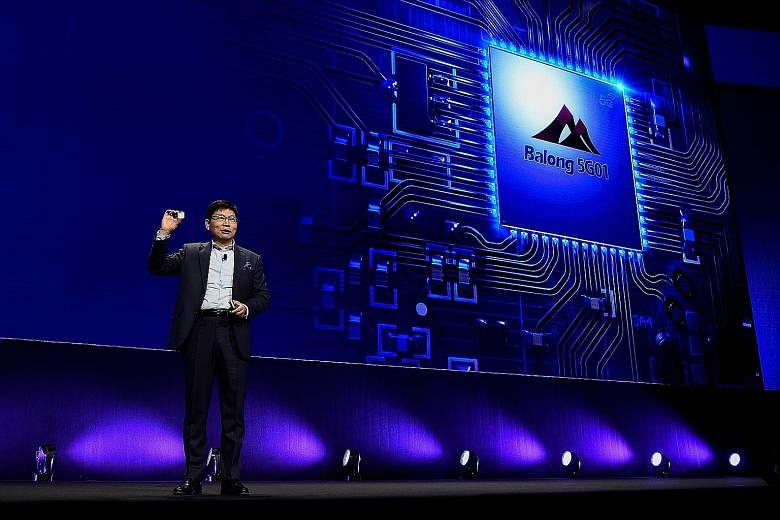SAN FRANCISCO • Being at the forefront of a new technology often provides a strategic advantage. That helps explain why there is so much scrapping now by companies and countries over a next wave of wireless technology known as 5G.
5G is shorthand for fifth-generation wireless technology, and it essentially brings ultrafast wireless speeds to people. By sending billions of bits of data per second, up from peaks of hundreds of millions today, 5G could cut the time to download a movie to seconds. Other 5G features would allow autonomous cars and industrial equipment to reliably exchange short bursts of data at blinding speed.
Technology companies, including Qualcomm, Intel and China's Huawei, have been working on developing 5G technology and standards. But even with 5G still in its infancy, the US government underscored its importance with an unprecedented move this week to intervene in Broadcom's US$117 billion (S$154 billion) bid for Qualcomm.
In a letter on Monday, the Committee on Foreign Investment in the United States (CFIUS) said it would investigate the proposed deal, partly because it was concerned that if Broadcom bought Qualcomm, it would weaken Qualcomm and "leave an opening for China to expand its influence on the 5G standard-setting process".
Broadcom, which is based in Singapore but is planning a move to the US, swiftly rejected the idea that it would push 5G development less aggressively.
"There can be no question that an American Broadcom-Qualcomm combination will provide far more resources for investments and development to that end," a Broadcom spokesman said.
Companies still have room to influence 5G technology because it has not yet been deployed.
As of now, a group called 3GPP - staffed by engineers from many companies - has been defining the specifications so that devices that operate with 5G technology can "talk" to one another. The group delivered its first major set of standards in December.
Signals Research Group analyst Mike Thelander predicted that US carriers will have some 5G services operating in late 2018, but that smartphones using the technology will not be ready until next year.
Qualcomm has long been one of the most active contributors of cellular technology, playing a particularly influential role in 3G technology as well as current 4G networks. Yet the effort to develop 5G standards has brought many new players to the fore, including Huawei, a relative newcomer to the field.
Huawei, which makes gear like cellular base stations and other key equipment to operate 5G networks, has been largely blackballed from the US on national security grounds. But its sales have surged elsewhere, such as in Europe, and the Chinese firm has taken a leading role in submitting technology for inclusion in 5G standards.
The CFIUS letter estimated that Huawei owned 10 per cent of the patents essential for 5G networks.
A Huawei spokesman said it had been working on 5G since 2009, having spent US$600 million on related research and committing US$800 million more in this year alone.
Many US carriers also buy cellular equipment from Sweden's Ericsson, which has long helped set cellular standards and estimates it has been working on 5G for a decade.
Other major contributors include South Korea's Samsung Electronics, Finland's Nokia and several companies in Japan. Intel, which has been determined to reduce Qualcomm's market dominance in wireless chips, has also significantly stepped up efforts to influence 5G standards.
Officials appointed by President Donald Trump have pointed to regulatory barriers that have kept the US behind nations such as China, which has a national plan for 5G networks using technology by Huawei and other Chinese companies like ZTE.
Last month, US Federal Communications Commission member Brendan Carr, a Republican, announced a regulatory plan that would allow wireless carriers to bypass environmental assessments for the construction of 5G wireless infrastructure.
At last week's Mobile World Congress, which is one of the biggest wireless trade shows, companies were quick to provide evidence of their leadership in 5G.
Huawei, for example, demonstrated the first cellular base station that complies with the new 3GPP specifications, said analyst Will Townsend from Moor Insights and Strategy, a research firm.
Still, others at the event, which was held in Barcelona, Spain, said it was hard to top Qualcomm's presence.
The San Diego-based company, which gets much of its profits from licensing patents rather than selling chips, listed a string of technologies it has shaped for 5G.
"If you walked through Qualcomm's booth at Mobile World Congress, it is an amazing thing, in terms of the breadth of the technology they show and the quality of people they have staffing it," said Mr Robert DiFazio, a vice-president in the research arm of InterDigital, another company that contributes to cellular standards.
NYTIMES

